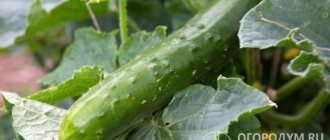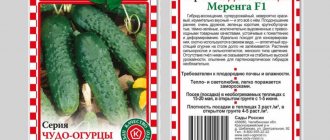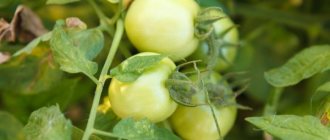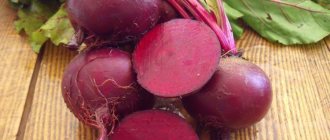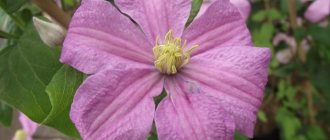Pablo F1 beetroot is a hybrid table variety originally from Holland. Refers to mid-early crops with a growing season of 1-2 months. It is very popular among residents of cold regions because it is a cold-resistant plant and easily tolerates frost. At the same time, beets have a sweet taste and can be used for any type of processing. You can use it to prepare salads, first courses, vegetable side dishes and even caviar.
Description of characteristics
Pablo's hydride was developed in the Netherlands by Bejo Zaden. Its main characteristics can be found below:
| Property | Description |
| Purpose | Pablo is suitable for long-term storage, processing and fresh consumption. Thus, it is a popular hybrid variety of table beet. |
| Ripening period | The growing season (from the appearance of the first shoots to the ripening of full-fledged root crops) averages 100-115 days. |
| Productivity | From 1 sq. m of sown area, you can collect up to 7 kg of root crops. Due to its high yield, this hybrid is often grown commercially for sale. |
| Growing area | It can be grown in any climate zone, including regions with cold climates, as it is resistant to adverse weather conditions. Often grown throughout Russia, Moldova and Ukraine. Does not require high-quality soil and careful care. |
| Plant | The leaves of the plant are medium in size, light green in color, have purple veins and wavy edges. The rosette is medium-sized and erect. The plant is resistant to lack of moisture and bolting. |
| Roots | Pablo bears fruit with rounded roots with thin tails. The average weight of one hard fruit is from 110 to 180 g, and the diameter is from 10 to 15 cm. The root vegetables have a smooth, thin burgundy-colored skin. The pulp itself is juicy, ruby red in color with a purple tint, without inclusions and light ring divisions, which are characteristic of many other beet varieties. The pulp contains a large amount of sugar (about 18%) and betaine (128.7 mg per 100 g), so it has a rich sweet taste. Retains its aroma and sweetness even after heat treatment. |
| Keeping quality | The hybrid has a high shelf life - it can be stored for several months without losing its shape and taste. In addition, it does not rot and does not become moldy. |
| Disease resistance | Pablo is resistant to many diseases that affect beets, including cercospora blight. |
Pablo beets are valued for their high yield, decent presentation and excellent taste.
History of the variety
Many varieties of vegetable crops with improved characteristics were bred by breeders from the Netherlands and are deservedly popular among farmers around the world.
Pablo f1 beets are also the fruit of Dutch selection
. When breeding this variety, experts wanted to obtain a vegetable plant with increased resistance to cold weather, good yield, good taste and the possibility of long-term storage. And Pablo’s hybrid, indeed, has all of the above properties.
Photo of Pablo's beets
Currently, this hybrid is grown in Russia. And thanks to its high resistance to possible drops in air temperature, Pablo beets can be grown in the middle zone and in other regions with similar climatic conditions in open ground.
Radish!
Daikon Dubinushka
Landing dates
Pablo beets are planted in late spring - early summer, approximately from the end of April to the first ten days of May or in the first third of June. Experienced gardeners recommend focusing on air temperature when determining the optimal planting time. They should be kept in the range of +18…+20°C.
In addition, the soil itself must be well heated - at least +5...+7°C, but up to 10°C. In general, the hybrid is suitable for early sowing.
If you plant beets later, when the soil temperature reaches 15°C, seedlings will subsequently appear with a delay of a week.
Preventive measures against damage
Many representatives select the Pablo variety for the reason that it is quite resistant to pests. Many diseases, which are even more serious in their severity than those listed above, are not capable of damaging the plant. But beets have been damaged by certain types of rodents. In order to scare them away, you need to sprinkle the soil with ash, or use the so-called tobacco dust. You can also reduce rodent damage in advance, for example, in the fall. This process can be carried out in this case if you do a deep digging of the soil.
A variety called Pablo F1 is a very productive crop . Due to the fact that the type of beet is quite stable in the cold season and also tolerates drought well, it has become popular in many cities of our country. The fruits of the plant are very tasty and are well suited for preparing many dishes.
If you find an error, please select a piece of text and press Ctrl+Enter.
Site selection and soil preparation
To grow the crop, you should choose an area that is well lit by sunlight. The fact is that with insufficient light, the ground part of the beets will become excessively elongated, and the yield will decrease.
It is desirable that the soil on the site be loose loamy with neutral acidity. If it is increased, then the beets will feel uncomfortable, which will affect the quality characteristics of the root crops.
The best predecessors of beets are the following crops:
- onion;
- tomatoes;
- potato;
- cucumbers;
- salad;
- radish;
- radish;
- garlic;
- kohlrabi.
You cannot grow beets in an area where the following crops previously grew:
- carrot;
- cabbage;
- chard;
- beans;
- spinach;
- corn.
It is advisable to prepare the selected area in the fall. To do this, after harvesting the previous harvest, it is necessary to completely remove plant residues and fertilize the soil with compost or humus at the rate of 5 kg per 1 sq. m. m of sown area. If necessary, the acidity level can be lowered by adding 200-400 g of lime per square meter of area.
Diseases and pests
During cultivation, beet crops may be subject to pest attack or disease outbreaks.
Common diseases:
- Cercospora blight . The causative agent of the disease is the fungus Cercospora beticola Sacc. This disease spreads during wet and warm weather. Fungal spores are found in the soil. Purple spots are visible on the leaves, with a darker border and a light center. Over time, a hole forms in the center of the spot. There is a whitish coating on the back of the leaves. Prevention and treatment: removal of plant residues in the fall, disinfection of seeds, treatment of plantings with fungicides every 10–14 days, no thickening in the row, compliance with crop rotation.
- Ramulariasis . Fungal disease. The initial symptoms are very similar to cercospora: the leaves also become covered with burgundy spots. At the beginning of the disease, the spots have a small diameter and brown-green color, gradually the diameter expands to 1.5 cm. The spot has a border without clear outlines. Over time, the tissue inside the stain dries out and falls out. The disease develops in late July or August at low temperatures. How to fight: carry out regular treatments of plantings with systemic fungicides.
- Downy mildew . The second name of the disease is downy mildew. This is a fungal disease, the first symptom of which is yellowing of the leaves, then the tops curl and die. A brown coating can be seen on the back of the affected leaves. Prevention and treatment: cleaning up the remains of previous crops in the fall, disinfecting seeds. Regular treatment of crops with systemic fungicides is carried out during the growing season.
- Fusarium . Fungal disease of beet leaves and root crops. Manifests itself in the form of yellowing, wilting or discoloration of young leaves. Root crops affected by fusarium do not grow well, and later they become as if wooden. Prevention and treatment: fertilizing with mineral and organic substances (feeding with boron is especially important), adding lime to acidic soils, using crop rotation, regular watering and loosening.
The most dangerous pests of beets:
- White beet nematode . One of the most dangerous pests in beet growing. Crop losses of up to 50% are possible. These pests infect the soil, and subsequently the root crops become infected. The presence of nematodes can be determined by the many small roots on the beets - the “beard”. Prevention and treatment: the most important thing is compliance with crop rotation. When growing root crops in a two-year crop (for seeds), uninfected mother beet plants should be used.
- Weevil . A long beetle with a gray chitin color, the body length is from 1 to 1.5 cm. It is very dangerous for young seedlings because it feeds on leaves. It can eat young seedlings in a few bites, leaving only the stem. The female lays eggs in the soil, and the pest also overwinters in the soil. Prevention and control measures: soaking the seed in insecticides, if necessary, treat newly emerged plants with insecticides on the leaf, use annual crop rotation.
- Aphid . Small insects with a black or dark green body length from 1.7 to 2.7 mm. They feed on the juice of leaves, reproduce quickly, and can be seen with the naked eye. Insects are found on the undersides of leaves and seed shoots. Prevention and treatment: destruction of weeds in garden beds, breeding ladybugs, treating crops with organophosphorus insecticides.
- Scale insect, or beet bug . It feeds on leaves; a large population can completely consume a young plant. The beetle has a brown or greenish carapace color, the length of the body is 6–7 mm. Prevention and treatment: keeping the beet field clean of weeds, treating with insecticides at least twice a month.
How to prepare seeds?
In no case should pre-treatment of seeds be neglected, otherwise the plant will grow weak and be susceptible to various diseases, even though Pablo is a resistant hybrid to many ailments, which is why it is chosen for cultivation by many gardeners.
Pre-sowing seed treatment is carried out according to the following instructions:
- Select quality material and remove hollow seeds. To do this, they need to be soaked for 20-30 minutes in a saline solution prepared at the rate of 30 g of salt per 1 liter of water. For planting, use only those seeds that remain at the bottom of the container.
- Disinfect suitable seeds. You will need to prepare a solution at the rate of 1.5 g of boric acid per 1 liter of boiling water, and then soak the seeds in it for 12 hours.
- Soak the seeds for a day in a solution prepared by dissolving 10 drops of Energen or 1 tsp in 1 liter of water at room temperature. superphosphate. This procedure will increase the rate of plant germination in the future.
- Wash the seeds, cover with a damp cloth and leave for 2-3 days at a temperature of 20°C. As the seed dries, it should be moistened.
Only after such treatment will the seeds be ready for planting.
Planting methods
You can plant beets in one of two ways - without seedlings or seedlings. Let's consider each of them separately.
Seedless
Sowing of prepared seeds is carried out according to a one-line scheme:
- Prepare furrows 2-3 cm deep in the area. The optimal distance between them is 30-40 cm.
- Throw 2 seeds into each hole at a distance of 7-10 cm, and then cover with soil.
- Lightly moisten the soil and loosen it by making a furrow with a hoe at a distance of 10 cm from the sowing line.
Each beet seed produces 2 sprouts, so in the future it will be necessary to thin out the plantings. When 2 leaves appear, leave 3-4 cm between plants, and when 3-4 leaves appear, about 8-10 cm. Thinning is best done in the evening after watering or precipitation.
Rassadny
To increase the survival rate of the plant and protect it from possible return frosts in the future, some gardeners plant seeds in seedlings. Its essence is to first plant the seeds in special containers and transfer them to open ground at the seedling stage.
It is necessary to sow seeds for seedlings 3 weeks before transplanting the plant into open ground. In this case, you should adhere to the following instructions:
- Prepare containers measuring approximately 10x20x20 cm.
- Mix coarse sand, peat and turf soil in equal parts to obtain a nutritional composition for growing seedlings. Add 200 g of wood ash to 10 kg of prepared mixture.
- Fill the container with substrate so that there is a distance of 2-3 cm between the edge and the soil mixture. A hole should be made in this part of each die to prevent moisture from accumulating in the soil.
- Moisten the substrate and sow the seeds to a depth of 1-1.5 cm and at a distance of 3 cm, and then sprinkle with soil.
- Sprinkle the substrate with water and cover the container with glass or film.
When growing seedlings, there is no need for picking, however, you should adhere to a number of other rules for caring for seedlings:
- Before sprouts grow, seedlings do not require lighting, but do need a moist environment. In this regard, it is necessary to water the substrate as its top layer dries.
- Maintain the indoor air temperature at +22…+25°C. As soon as the sprouts appear, remove the glass or film and place the cups in a bright place.
- Provide adult seedlings with 2 or more leaves with lighting from morning to 19:00. If beets grow in a dark place, the shoots will turn out thin and weak, and productivity will significantly decrease. So, if necessary, additional lighting should be provided using fluorescent lamps, which should be installed at a distance of 20 cm from the seedlings.
- There is no need to feed the seedlings, since the substrate contains a sufficient amount of nutrients.
- A week before transplanting into the ground, begin hardening off the seedlings. Every day, take it out into the fresh air for 3-4 hours, and then extend the time to 5 hours. Acceptable air temperature is from +8 to 10°C. In an apartment, hardening can be carried out on a balcony or loggia. In this case, direct exposure of the seedlings to sunlight should not be allowed.
Seedlings with 5-7 leaves can be transplanted into open ground. At the same time, the air temperature at night should be kept at 15°C. Plants need to be planted with a clod of earth at a distance of 4-5 cm. Between the rows you need to leave a distance of about 30 cm.
When the seedlings are accepted and the root crops increase to 1.5-2 cm, the beets should be thinned to an interval of 10 cm.
Wind and sun can damage fragile and thin plants, so they should be covered with non-woven material. To do this, you need to install metal arcs around the perimeter of the bed, onto which you will stretch a protective film. It can be removed in June as the leaves of the tops close.
Pablo beets: reviews from those who planted
Anna, 48 years old, Volzhsky: I learned about the Pablo beet variety from the Internet, where I also read its description and the main characteristics of the root crops. I was attracted by the high yield and good taste of ripe beets, so I decided to plant a bed of this hybrid in the garden for testing. I rarely planted, but I still had to tidy up the garden bed a little. The germination rate of Pablo's beet seeds was almost 100%. The first root crops were dug up already in the first ten days of August. I made a salad from them, and the beets turned out to be sweet and very tasty. I even regretted that I planted little. Next season I will only grow it.
Yield varieties of zucchini!
Video Iskander
Natalya, 39 years old, Chelyabinsk region: In our region, root crops do not always have time to ripen due to the short summer season. Last season I tried to plant the Pablo beet variety in open ground. It turned out that this hybrid really calmly tolerates sharp drops in temperature, which we often experience not only in the spring, but also during the summer season. Despite the cold snap, the beets grew well and did not suffer from any illness during the summer. And in mid-August they harvested a large harvest of sweet root vegetables. We put the collected beets in the cellar for storage and ate them almost all winter. And they probably would have eaten longer, but the root vegetables had simply run out. Next year we will plant more.
Irina, 55 years old, Volgograd region: Last season we decided to plant a variety of beets that could be stored in the cellar. The store clerk advised me to plant Pablo's beets. As a result, I bought a couple of bags; there were enough seeds for a couple of large beds. They came to the dacha infrequently - a couple of times a week, and although the season was quite hot, this hybrid did not suffer from drought, the tops did not wither, and the root crops developed well. As a result, in mid-August, approximately 5 kg of root crops were collected from one square. We were pleased with the taste of the fruit. They lowered it into the cellar and took out these beets almost all winter, but their taste did not deteriorate. I recommend this hybrid to everyone.
The Pablo beet variety is valued by farmers for its excellent yield, excellent presentation and good taste.
. It is also worth noting the medium-early ripening of root crops and the possibility of storing them. Therefore, this hybrid is usually recommended for cultivation on an industrial scale for further sale, as well as for cultivation in personal backyards.
Useful video
How to care for planting?
Pablo is an unpretentious hybrid to grow, but to get a good harvest you should follow simple care rules:
- Watering . Pablo is resistant to prolonged absence of moisture, but do not neglect watering the plant. In cool weather, do it once a week, and in dry weather - 2-3 times a week. In any case, the water norm is 15-25 liters per 1 square meter. m plot. Before watering, the water should be left to steep for 1-2 days. It should be poured at the root of the plant using a watering can or drip irrigation system. Stop watering in mid-August as this will increase the volume of root crops.
- Loosening and weeding . After watering or precipitation, the soil between the rows should be loosened to a depth of 5-10 cm, since the formation of a soil crust around the plant leads to a decrease in the quality of the crop. In addition, loosening improves air circulation. It is also worth weeding regularly, especially at the beginning of seedling germination, since during this period it most needs light, moisture and nutrients.
- Hilling up . If the root crops are not completely covered with soil, they need to be hilled.
- Top dressing. Fertilizers for beets are applied 2-3 times. The first fertilizing is carried out after thinning - 10-15 g of nitrogen fertilizers (urea, sodium or calcium nitrate, ammonium sulfate) are introduced per square meter. At the same time, you should not overdo it with nitrogen fertilizers, since nitrogen can penetrate and accumulate in the root crop, and then negatively affect the human body. The second feeding is carried out 2-3 weeks after the first - 8-10 g of potassium chloride and superphosphate are introduced for each square meter.
If beet leaves become covered with red spots, this indicates a lack of sodium in the soil. In this case, the plant should be watered with salt water (1 tbsp per 10 l). During the entire growing period, it is enough to carry out 3 such procedures.
- Protection from diseases and pests . Pablo F1 beets are resistant to many diseases, including cercospora and bolting. In addition, the hybrid is quite rarely affected by scab or root beetle. To completely minimize the likelihood of damage, you should promptly remove weeds and apply potassium-phosphorus fertilizers to the soil. A great threat to beets is posed by rodents, which can harm both the tops and root crops. To scare them away, the planting furrows should be sprinkled with tobacco dust, ash or special preparations. In addition, in the fight against rodents, it is worth digging up the soil deeply in the fall and spring.
With proper care, already in mid-August - early September you can get an excellent harvest - on average 2 kg per 1 sq. m plot.
Beetroot Pablo F1: reviews, photos, description of the variety, rules of cultivation, planting and care
Beetroot is a root crop that is actively grown by farmers from different countries.
. It is used for preparing first and second courses, salads, and is also added to various preparations for preservation. The root crops of this vegetable crop can also be stored for long-term storage, and if certain conditions are created, many varieties of beets can be stored until a new harvest.
This article will present a beet hybrid of the Dutch selection Pablo F1: main characteristics, yield, advantages, nuances of cultivation - all this will be discussed below.
The content of the article:
History of the Pablo beet variety F1: description of the variety Pablo beet yield Advantages and disadvantages Diseases and pests Pablo beet: planting and cultivation Reviews of those who planted the Pablo beet variety Description and characteristics from the manufacturer
Harvest and storage
About 100 days pass between the emergence of seedlings and the complete ripening of root crops. It is extremely undesirable to delay harvesting and keep beets in the ground, as this will worsen their taste and marketability.
The readiness of root crops for harvesting can be determined by a number of signs. These include:
- the condition of the lower foliage (it begins to dry, wither, turn yellow and fade);
- the size of the root crops (their diameter reaches 10-15 cm, and characteristic growths appear on the skin).
To harvest, root crops should be removed from the soil using a pitchfork. This way you can remove the top layers of soil without damaging the beets themselves. The leaves of the extracted root crops must be trimmed, leaving cuttings no larger than 1 cm in size, so that beet growth does not become more active in winter, which can cause its death.
Root crops need to be cleared of soil, placed in boxes with a capacity of 10-20 cm and covered with a layer of sand up to 3 cm. In addition, the crop can be stored in pits, the width and depth of which is 1 m. Before laying the root crops, the bottom should be covered with boards. The beets need to be sprinkled with sand, and then covered with dry leaves, peat or straw, and then with a layer of earth.
Beets should be stored at a temperature of 0…+2°C and humidity up to 90%.
Watering
Before watering, make sure there are no weeds between the rows. Watering should be done once a week so as not to oversaturate the soil with moisture. Beets have very small roots, so they need to be moist but not wet. In dry weather without watering, beets will become hairy and stringy. Under-watering or over-watering can cause cracks and damaged roots. Excess moisture promotes the growth of tops, while the roots remain small and immature.
In cold weather, it is recommended to water the plants once a week. In hot weather, watering is carried out once every two to three weeks.
Beneficial features
Pablo beets are rich in vitamins, organic acids and microelements, and also contain an increased amount of sugars and betaine, which determines its beneficial properties:
- removes radionuclides, waste and toxins from the body;
- has a beneficial effect on metabolic processes;
- normalizes the functioning of the gastrointestinal tract;
- reduces cholesterol levels in the blood with regular use;
- strengthens the walls of blood vessels and stimulates hematopoiesis, so the vegetable is especially recommended for use in case of blood diseases;
- reduces inflammatory processes and accelerates wound healing;
- prevents the appearance of swelling by removing excess fluid.
Pablo F1 can be confidently used for anemia, cardiovascular diseases, ulcerative lesions, malfunctions of the digestive system, general exhaustion of the body and the appearance of characteristic symptoms of asthenia.
Features of care
There is nothing easier than growing beets. It is undemanding to care, but to obtain a higher yield the following work should be carried out:
- Loosening. After the plants sprout, the soil is loosened. This is necessary in order to retain moisture and provide oxygen access to the roots. Do this repeatedly, after each watering or heavy rain.
- Watering. Provide the crop with moisture regularly; getting the right amount of water directly affects the yield of the plants.
- Feeding. The culture itself does not require additional minerals. Fertilizing with nitrogen content is limited; it settles in the vegetable and negatively affects human health. Potassium fertilizers perform well; they affect the volume of the crop and accelerate the process of plant development.
- Weeding. Weeds are especially dangerous for small plants; they draw all the nutrients from the soil, causing crops to starve.
Following simple care rules will help you get the desired harvest.
Contraindications
Despite all the beneficial properties, Pablo F1 can pose a health hazard if used for indications such as:
- metabolic disorders (food consumption of beets should be minimized, especially in case of diseases of the genitourinary system or kidneys, since it is rich in oxalic acid);
- diabetes mellitus of any type (the use of boiled beets is especially contraindicated, since it contains a large amount of sugar);
- gastritis with low or zero acidity and other diseases of the gastrointestinal tract.
Pablo F1 beets are a mid-early hybrid of Dutch selection, which is characterized by high and stable yields, increased sugar and betaine content, as well as an increased ability to remove radionuclides from the body and reduce cholesterol levels in the blood. Every summer resident can grow such a useful vegetable in his garden using simple rules for planting and caring for the crop.
0
0
Copy link
